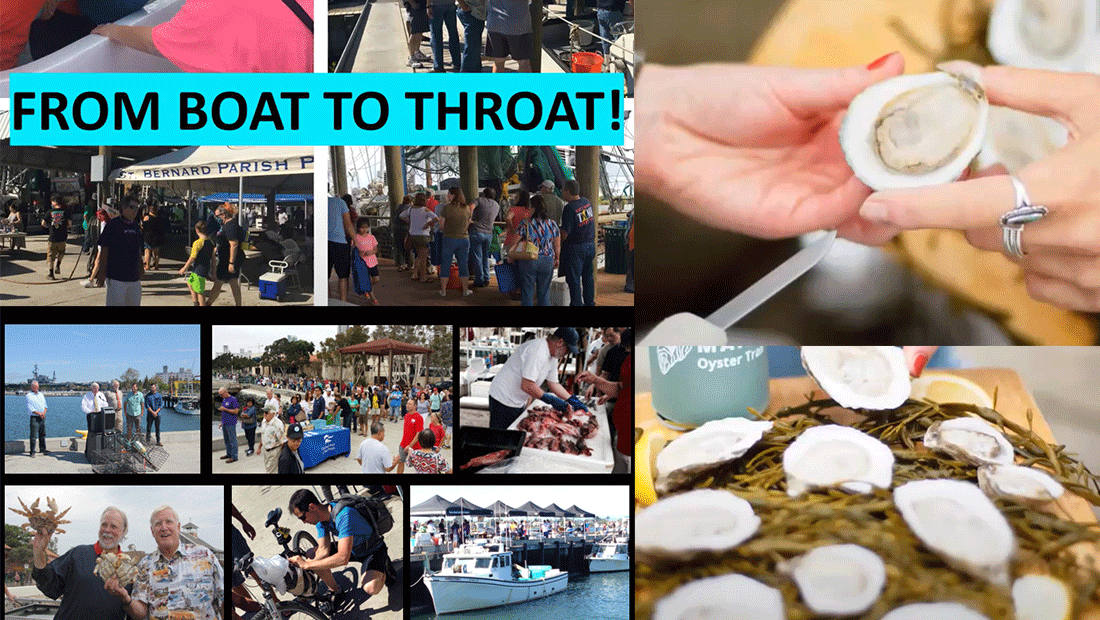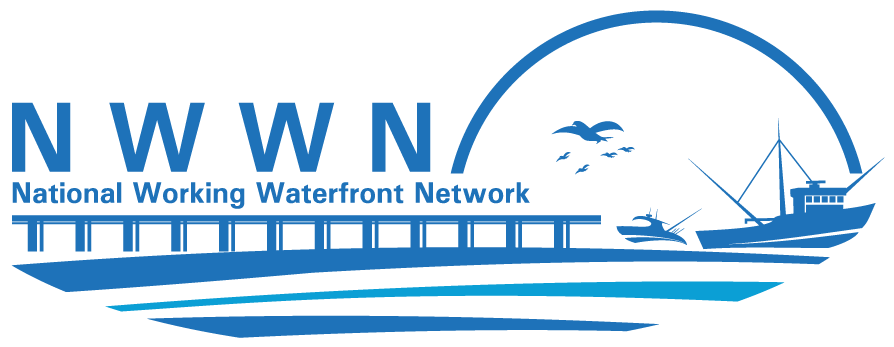
04 Oct Selling Fish to Sell Fishing
Written by Shannon Hogan, Urban Harbors Institute
The United States commercial fishing industry faces many challenges including how to reach new consumers, increase domestic sales while competing with imported seafood, and highlight the sustainability of fisheries. These challenges were a major theme at the last NWWN conference in 2022 in Boston, Massachusetts, and the COVID pandemic only made matters worse when international commerce was interrupted and restaurants closed, cutting off a major market for the industry.
To keep the conversation going and spark new discussion, the NWWN hosted a webinar in September highlighting how commercial fishing communities in California, Louisiana, and Maine developed opportunities to engage with their consumers and create new markets for seafood sales at the working waterfront.
Peter Halmay, a longtime commercial fisherman and sea urchin diver in San Diego, highlighted his work with the Tuna Harbor Dockside Market. The open-air seafood market at the Port of San Diego opened in 2014 with an unanticipated 1,500 customers who attended the market’s opening, showcasing the high demand for direct seafood sales. The market has become an important fixture in the Port and has been able to influence significant port investments. As Peter put it, “we thought we would sell fish but what we ended up selling was fishing.”
Jaclyn Robidoux, a Marine Extension Associate at Maine Sea Grant, presented her work with the Maine Oyster Trail, the first interactive, incentive-based oyster trail in the U.S. The trail assists the public with finding oyster farm tours, raw bars, boat tours, and opportunities to buy oysters directly from farmers along the Maine coast. While the trail has been around since 2015, it was revamped in 2020 as the pandemic brought increased awareness of direct sales.
Dominque Seibert, a Marine Extension Agent at Louisiana Sea Grant, discussed her work on opening the St. Bernard Seafood Market. Local officials wanted to highlight the quality of local seafood, increase tourism, and support the economic sustainability of commercial fishers through a direct seafood market. The St. Bernard Seafood Market boasts several food and drink vendors promoting the community’s culture and allows consumers to buy fresh, wild-caught local seafood right from the fishers’ boats.
While there are differences between each initiative, they faced similar obstacles and have some important takeaways.
Plan and review your state and local government laws/regulations
All of these efforts required a year or more of planning before their visions became a reality. The idea for San Diego’s Tuna Harbor Dockside Market was proposed two years before opening day. The Maine Oyster Trail was proposed in 2011 (and began in 2015) but met significant barriers due to state laws regulating the ability of farms to sell oysters directly to consumers. Both initiatives required a change in policy at the state level. In 2014, Maine state laws changed giving farmers the ability to sell oysters directly off their farms. Peter Halmay and his team assisted with authoring a new bill – Pacific to Plate – placing a fisher’s seafood market into law and allowing commercial fishers to process seafood directly at the docks.
There’s strength in numbers
Collaboration is key. All of the initiatives involved partnerships and required the assistance of several organizations at the state and local levels. Jaclyn from the Maine Oyster Trail stressed, “It is important to lean on your state agencies and departments as there are many resources to take advantage of.” This goes for local governments as well. Potential state and local agencies to involve:
- State and local elected officials
- Departments of Natural Resources (or Marine Resources)
- Departments of Environmental Health
- Offices of Tourism and/or Economic Development
- Boards of Health
- Port agencies and organizations
Additionally, when needed and if possible, hire a consultant to take on work that may not be within your expertise. For instance, the Maine Oyster Trail involved translating different information from over 80 businesses into a single online platform. It was a big hurdle and required working with a web developer.
Talk to the commercial fishers and aquaculturists
Peter, Jaclyn, and Dominique all emphasized the need for engaging with the commercial fishing industry, associated businesses, and the surrounding communities during planning. The fishers, oyster farms, businesses, and other relevant entities need to be involved from the ground up and have an interest in the proposed efforts. Obtaining feedback from the industry and community can be done through surveys or directly by speaking with members. Ask them what is most important when it comes to direct marketing, what they want to highlight and showcase (e.g., quality of local seafood, the importance of commercial fishing, tourism), and potential ways to promote direct sales and the industry.
Promote engagement and take advantage of social media
The speakers expressed the significance of having social media to promote their efforts. However, having a Facebook or Instagram page likely won’t make a difference if you are not posting content regularly. Posting daily or one to two days a week will keep followers engaged as they will see updates from your page come through their feeds.
To take the burden of keeping up with content off a single entity, teach commercial fishers, businesses, and others involved how to have their own social media pages (if they don’t already have them) so they can also post. Dominique with the St. Bernard’s Seafood Market taught local fisherman to use Facebook, “None of them had social media before and now they post all the time. They share highlights of their seafood products, and post when they’re going out to fish, and when they’re coming back.” If possible, when posting content, tag any relevant commercial fishers, businesses, oyster farms and other partners. In addition, investing in social media by hiring someone to focus solely on generating and posting content was a recommendation by the speakers.

